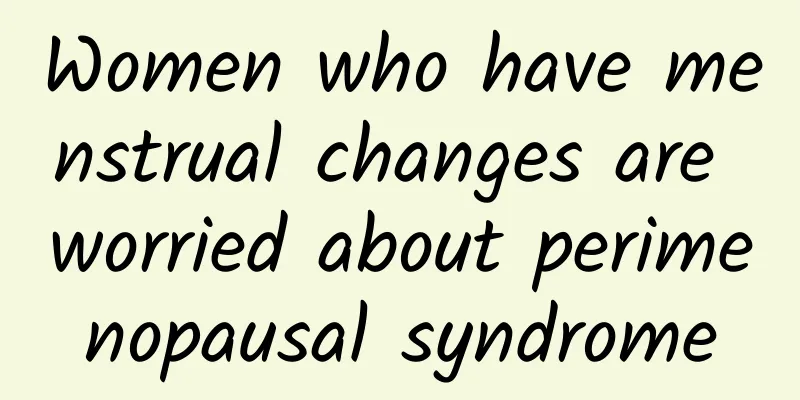Women who have menstrual changes are worried about perimenopausal syndrome

|
Perimenopausal syndrome, also known as menopausal syndrome (MpS), refers to a series of syndromes caused by fluctuations or decreases in sex hormones before and after menopause in women, mainly characterized by autonomic nervous system dysfunction, accompanied by neuropsychological symptoms. Menopause can be divided into natural menopause and artificial menopause. Natural menopause refers to the exhaustion of ovarian follicles, or the loss of response of the remaining follicles to gonadotropins. The follicles no longer develop and secrete estrogen, and cannot stimulate the growth of the endometrium, leading to menopause. Artificial menopause refers to surgical removal of both ovaries or other methods to stop ovarian function, such as radiotherapy and chemotherapy. Removal of the uterus alone while retaining one or both ovaries is not considered artificial menopause. So, what are the main symptoms of perimenopausal syndrome? The fundamental reason for perimenopausal syndrome is ovarian failure due to physiological, pathological or surgical reasons. Once the ovarian function fails or is removed and destroyed, the estrogen secreted by the ovaries will decrease. There are more than 400 estrogen receptors in the female body, distributed in almost all tissues and organs of the female body, which are controlled and dominated by estrogen. Once the estrogen decreases, it will cause degenerative changes in organs and tissues, resulting in a series of symptoms. The most typical symptoms of perimenopausal syndrome are hot flashes and flushes. They usually occur between the ages of 45 and 55. Most women may experience symptoms of varying severity. Some begin to experience symptoms during the menopausal transition period and continue until 2 to 3 years after menopause. For a few, symptoms may not be alleviated or disappear until 5 to 10 years after menopause. Those who undergo artificial menopause often experience perimenopausal syndrome 2 weeks after surgery, reaching a peak 2 months after surgery, and can last for 2 years. 1. Menstrual changes Changes in the menstrual cycle are the earliest clinical symptoms of perimenopause and are divided into three types: 1. The menstrual cycle is prolonged, the menstrual volume decreases, and finally menopause occurs. 2. Irregular menstrual cycle, prolonged menstrual period, increased menstrual flow, even heavy bleeding or continuous bleeding, which then gradually decreases and stops. 3. Sudden cessation of menstruation is rare. Due to the absence of ovulation in the ovaries, estrogen levels fluctuate, which can easily lead to endometrial cancer. For those with abnormal bleeding, diagnostic curettage should be performed to rule out malignant changes. 2. Vasomotor symptoms The clinical manifestations are hot flashes and sweating, which are manifestations of unstable vasomotor function and the most prominent characteristic symptoms of perimenopausal syndrome. Hot flashes start from the chest, rush to the head and neck, and then spread to the whole body. In a few women, they are only limited to the head, neck and breasts. Patients feel burning and redness in the area of the flushing, followed by explosive sweating. It lasts from a few seconds to a few minutes, and the frequency of attacks ranges from several times a day to 30 to 50 times. It is easy to trigger at night or under stress. This kind of vascular instability can last for 1 year, sometimes up to 5 years or longer. |
<<: Can I drink coffee during menstruation? You should eat less of these during menstruation.
>>: Why is there blood on the seventh day of menstruation?
Recommend
How long does it take to cure cervical warts?
How long does it take to cure cervical warts? Cer...
What are the symptoms of uterine contractions after painless abortion? Two things to note after painless abortion
Abortion is an act that women do to resolve unexp...
No Hungry Summer Vacation - Crowd Lu: Helping disadvantaged children is very rock!
"Helping disadvantaged children is a very ro...
Unscientific female vulva cleaning can lead to the cause of adnexitis
Since many women do not know much about the cause...
I got adnexitis when I was pregnant.
During pregnancy, adnexitis may be related to dec...
How much does it cost to treat vaginal candidal infection?
Nowadays, more and more female friends suffer fro...
Are you still using sugar substitutes to lose weight?
The most irresistible thing when losing weight is...
What are the symptoms of multiple uterine fibroids? Will multiple uterine fibroids cause infertility?
According to the survey, about 20% of women over ...
Drink 3 spoons of brown sugar banana vinegar a day to lose 8 kg a month
Banana milk, banana ice, banana cake, chocolate b...
What are the causes of irregular menstruation? 5 common causes of irregular menstruation
1. Stress: Women are in a state of long-term supp...
What are the clinical symptoms of Bartholinitis?
Although Bartholinitis is not a particularly comm...
Experts explain how to prevent allergic vaginitis
Clinically, many female friends suffer from vagin...
What should women eat after uterine fibroid surgery? 9 dietary considerations for women with uterine fibroids
Hospital experts said that after uterine fibroid ...
What should I do if I have irregular menstruation after laparoscopic surgery?
What should I do if I have irregular menstruation...
Start the "fat burning motor"! Eating multi-grain rice balls helps metabolism
Afraid of getting fat and not daring to eat? In f...









